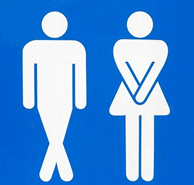 One of the numerous
infections that can be caused by a type of yeast known as Candida, thrush
affects around 75% of women at some point in their life, and can affect men
too. It can be a nuisance, causing discharge, discomfort and irritation, but if
you find it’s a common occurrence it may be a sign of an underlying problem.
(1)
One of the numerous
infections that can be caused by a type of yeast known as Candida, thrush
affects around 75% of women at some point in their life, and can affect men
too. It can be a nuisance, causing discharge, discomfort and irritation, but if
you find it’s a common occurrence it may be a sign of an underlying problem.
(1)
What is thrush?
Thrush, also known as
candidiasis, is the name given to a number of skin and mucous membrane
infections involving Candida, which is a group of several species of yeast
(fungus). In society, ‘thrush’ is generally defined as vaginal or penile
candidiasis, so the same definition applies to the term ‘thrush’ in this blog hereafter.
(2)
Symptoms of thrush in
women include an odourless vaginal discharge with the appearance of cottage
cheese, irritation and itching of the vagina and vulva, and pain or stinging on
urination or during sex. For men, thrush can cause irritation and burning of
the head of the penis and beneath the foreskin, pain on retraction of the
foreskin, a cottage cheese-like discharge and odour. But not everyone with
thrush will have all of the according symptoms listed - in fact, it is possible
to have thrush without any symptoms. (2)
What causes thrush?
Candida and certain
species of bacteria, known collectively as flora, live naturally in the vagina
and are beneficial in that they keep the acidity of the vagina at a healthy
level. However, particular factors can upset the balance of the flora and allow
Candida to proliferate, leading to thrush. Such factors include antibiotics,
pregnancy, being post-menopausal, poorly controlled diabetes, a compromised
immune system or broken or irritated skin in the vagina. Sometimes, having sex
or even periods can bring on an episode of thrush. (2)
Men may develop
penile thrush through sex with a female partner who has vaginal thrush. (2)
How is thrush
treated?
If you think you’ve
got thrush for the first time, you’ll need to visit your GP for a diagnosis and
to rule out anything else. Treatment comes in various forms, namely external
and vaginal creams, pessaries and oral capsules. (2, 3)
The mainstay of
treatment of thrush in women is a pessary or vaginal cream containing clotrimazole,
an antifungal. The pessary or cream usually only needs to be inserted into the
vagina once, as long as the high strength is used. Lower strengths are
available, but they will need to be used more than once. Other, less common
antifungals used in this way include econazole and miconazole.
(3)
If the vaginal forms
of treatment are unsuitable, fluconazole and itraconazole antifungal
capsules are available. Again, fluconazole can be taken as a single dose. (3)
To ease itching and
irritation of the vulva while the above treatment takes effect, creams
containing antifungals such as clotrimazole can be applied to the area several
times a day. (3)
To treat thrush in
men, a cream containing an antifungal such as clotrimazole may be applied to
the penis, or oral fluconazole can be taken as a single dose. As for women, the
cream can be used alongside the capsule to ease symptoms while the capsule
works. (3, 4)
If you’ve already had
a diagnosis of thrush in the past, you can visit a pharmacy instead of the GP
where you can buy clotrimazole-containing external and vaginal creams,
clotrimazole pessaries and fluconazole capsules over the counter.
When else will I need
to see the GP?
As well as
experiencing symptoms for the first time, there are several other instances
when you will need to see your GP or visit a sexual health clinic when you
develop thrush:
If you fall into one
or more of these groups, the healthcare professional you see may need to look
at the area to gauge whether it’s thrush or a different infection. If they’re
unsure, they may take a sample of the discharge using a cotton swab to send off
for testing. If you get recurrent thrush, your GP may run tests to check if
there is an underlying problem with your immune system. (2)
In men, thrush can
develop into a condition called balanitis. The head of the penis and the
foreskin can become red, painful and inflamed, with associated foul-smelling
discharge and painful urination. If you think you have balanitis you should
visit your GP. (5)
Can I prevent thrush?
There are certain
steps you can take to try to prevent bouts of thrush in the future. Opt for
showers as opposed to baths, use non-perfumed intimate washes or emollients
rather than soap on the groin area, and dry thoroughly afterwards. Wear
loose-fitting cotton underwear where possible and don’t douche or use
deodorants on your intimate area. (2)
References
- raTrust. Vaginal Thrush Overview [cited 7 February 2018]. Available at: https://ratrust.org.uk/sexual-health/stis/vaginal-thrush/overview
- NHS Choices. Thrush in men and women [cited 7 February 2018]. Available at: https://www.nhs.uk/conditions/thrush-in-men-and-women/
- British National Formulary (version 1.3.4) [Mobile application software]. Retrieved from: www.bnf.org
- Canesten. Thrush in Men [cited 7 February 2018]. Available at: https://www.canesten.co.uk/
- NHS Choices. Balanitis [cited 7 February 2018]. Available at: https://www.nhs.uk/conditions/balanitis/
Author: Gabby Gallagher MPharm
Medically reviewed by: Superintendent pharmacist Margaret Hudson BSc(Hons)MRPharmS 09/02/18